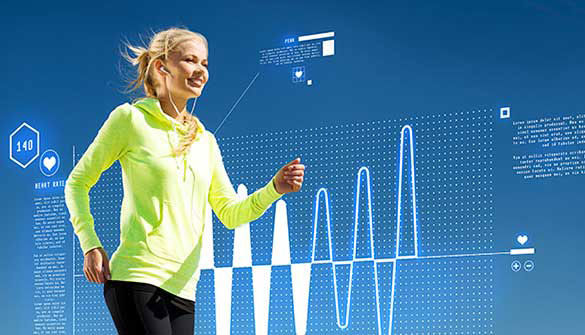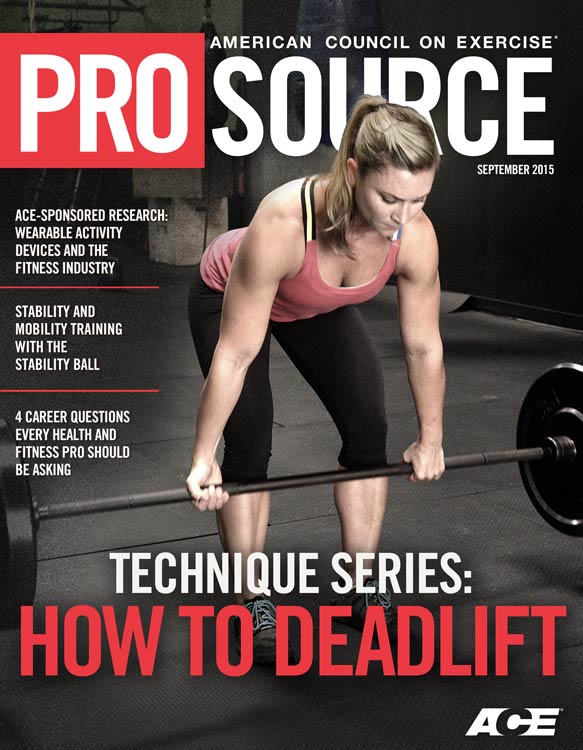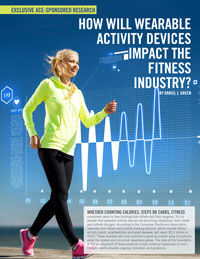
Whether counting calories, steps or carbs, fitness consumers seem to love tracking their efforts and their progress. It’s no wonder that wearable activity devices are becoming ubiquitous, both inside and outside the gym. According to the Consumer Electronics Association, revenues from fitness and activity tracking devices, which include fitness activity bands, smartwatches and smart eyewear, will reach $5.1 billion in 2015. These numbers will only continue to grow as a wider array of products enter the market and consumer awareness grows. The idea at the foundation of the development of these products is that continual awareness of one’s lifestyle habits provides ongoing motivation and guidance.
A common misperception exists that personal trainers are somehow against the use of this technology, in that they view it as a crutch—or as a threat that will someday render them obsolete. As you will see, the results of the survey outlined here do not reflect those concerns. In fact, there is a clear trend of personal trainers embracing the use of this type of technology—if it’s done well.
These devices can be used as a means of more efficient and effective interaction with health and fitness professionals, as they provide a means for clients to track their physical activity and nutrition habits when they are away from the gym. This gives you, the health and fitness professional, access to important data that was previously only available via the client’s self-reporting—a potentially biased and unreliable process. The consumer has clearly embraced wearable activity devices, so it must become our mission to determine how to integrate the technology into training programs, facility memberships and everyday client interactions.
Opportunities Abound
Companies developing these wearable devices should focus on having a meaningful impact on users’ behaviors and habits, as that should be the true end goal for everyone involved. This is the recommendation of Inov8 Health, which offers broad-based strategic consulting focused on delivering integrated business, sales and marketing strategies to its clients, and conducted this survey in partnership with ACE. According to Inov8 Health, long-term use of the devices is dependent on three factors:
- Habit formation. Sustained use of a device depends on its ability to help the user form and maintain new habits. To trigger the deep-seated psychological sequences that lead to the establishment of new habits, data (such as calories burned or steps taken) is not enough to influence the “cue–routine–reward” habit loop. This is an area of tremendous opportunity for group fitness instructors, personal trainers, health coaches, facility owners and the fitness industry as a whole.
- Social motivation. Social connections are a particularly powerful source of motivation that can be leveraged in many creative ways. Social media and networking sites affiliated with a device or app can be exploited to alter habits for positive outcomes. Health and fitness professionals can help drive this process.
- Goal reinforcement. The achievement of steppingstone goals has long been seen as an integral part of larger goal attainment. This is yet another opportunity for the fitness industry, as the real-time updates provided by wearable devices can be integrated into the ongoing programming process.
The Survey
ACE partnered with Inov8 Health, and its founder and CEO Tom Futch, to distribute a survey via email to ACE’s network of certified fitness professionals. The 22-question interactive online survey asked respondents to consider three key areas as they answered each question:
- How can wearable activity devices positively impact your business?
- How can these devices help your clients achieve and sustain success with their individual health and fitness goals?
- In regards to your ability to most effectively deliver value through these devices to your clients, what gaps do you believe exist in the wearable devices, the mobile applications and the user experience, and the overall integration within the fitness industry?
The Results
ACE Research on the Accuracy of Activity Trackers
ACE commissioned a team of researchers at the University of Wisconsin–La Crosse to answer the key questions most often asked by consumers: “Which device should I purchase?” and “How accurate is the device?”
The study five activity trackers: Nike+ Fuelband, FitBit Ultra, Jawbone UP, BodyMedia FitCore, and the Adidas MiCoach. They found that all five devices predicted within 10 percent accuracy the number of steps taken during treadmill walking and running, as well as during elliptical use. None of the devices did a particularly good job at measuring steps for agility-type exercise activities. When it came to predicting the number of calories burned, the devices, unfortunately, produced high error rates. That said, it appears that activity trackers can help users see whether they need to add more activity throughout the day and to spot trends in their behavior.
When deciding which device to purchase, the researchers recommend that consumers think about the information they want to track and determine which device is best suited for their needs and primary activities.
Here are some highlights of the survey results:
- 72 percent of respondents reported that clients or class participants ask for insight and feedback on wearable devices, but only 51 percent feel they are prepared to answer those questions.
- 86 percent of respondents said that a single platform that gathered their clients’ data from wearable devices and apps onto a single platform would be of value in programming and the training of clients and in their businesses. However, that number dropped to 44 percent when asked if they would be willing to pay for such a platform.
- 75 percent of those who completed the survey said they would be interested in the capability to run fitness challenges with clients using wearable activity devices.
- 71 percent said they would be interested in allowing clients to purchase devices, either directly from them or by using a promotional code. That number increased slightly to 74 percent when the possibility of earning revenue was introduced.
- 71 percent of respondents currently own a wearable activity device, and 61 percent of those who do not yet own one are considering purchasing one.
- The most common questions that health and fitness professionals hear from their clients regarding wearable activity devices are: “Which device should I purchase?” “How accurate is the device?” and “Will the device help me achieve my fitness/health goals?”
- The activity tracker about which clients most frequently inquire is the Fitbit, while the fitness app most frequently brought up by clients is MyFitnessPal.
- When asked about what gaps exist with the wearable activity devices, the most common responses were “the inability to track all of my physical activity (strength training, recreational activities, etc.),” “accuracy” and “better consumer education on the use of devices (how to set up, how to use, etc.).”
The Bottom Line

These results show that the majority of health and fitness professionals are hearing questions from clients about wearable activity devices, but that the professionals do not always feel qualified or educated enough to answer those questions. In addition, consumers appear to be unsure how to choose which device matches their individual needs, and they are not always sure how to best use the devices once they buy them. This suggests that better education is needed for everyone involved so that clients and trainers are making the most of their investments in this technology. Getting the data is not enough on its own, which is why the fitness industry would be wise to truly embrace the use of wearable activity devices and develop a process through which the numbers can transform into programming and progression—and eventual goal attainment.
According to Inov8 Health CEO Tom Futch, who has more than 25 years of experience in the digital health, wellness, and fitness industry, consumers can use these devices to interact with personal trainers more efficiently. “Health and fitness professionals can provide value to their clients when they are not in the gym by using the data to inspire and motivate them to stay active even when they are traveling or otherwise unable to have a training session,” says Futch. “They can also help clients form small groups to create valuable social support.” When used well by both trainer and client, Futch argues, these devices can facilitate behavior modification and sustained healthy habits.
Ted Vickey, M.A., is an entrepreneurial strategist and a Ph.D. candidate at the National University of Ireland Galway in exercise adherence and technology. He believes that trainers should incorporate technology, including wearable devices, social media and fitness apps, into their training. He goes on to say that what is missing from the data provided by wearable activity devices is accountability, which is a key role of health and fitness professionals. Tracking step counts, for example, teaches the client that achieving better fitness and health is not just about getting to the gym. Tracking a client’s step counts and setting goals to increase those numbers—which the trainer can review at each session—can be a good starting point for helping a client achieve a more active lifestyle.
Vickey says that the social aspects of sharing the information gathered by these devices are “tearing down the walls” of the gym by providing virtual motivation or even a sense of competition. Vickey likens the constant collection of data to the diagnostic process conducted by an auto mechanic when you bring your car in for service. “It’s like running a diagnostic for your body,” says Vickey. “These devices can monitor everything from steps taken and sleep duration to hydration levels and micronutrient consumption.” It’s the trainer’s job to transform all of that data into an action plan to drive long-term success.





 by
by 




